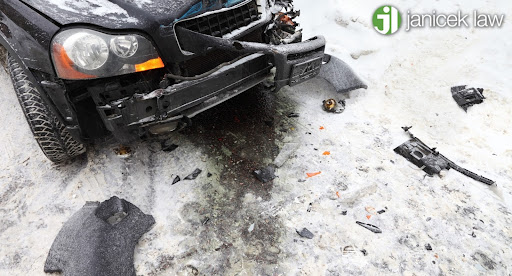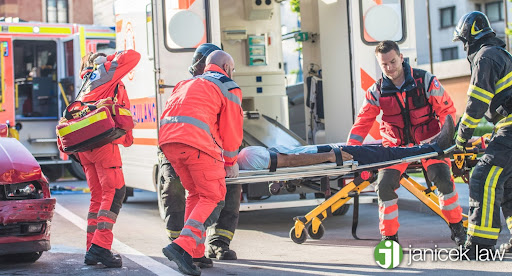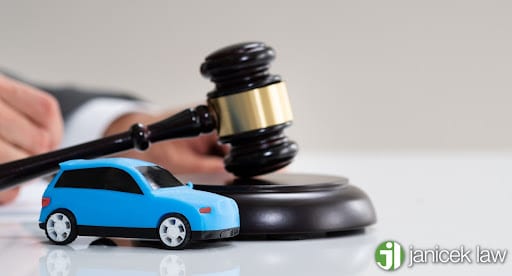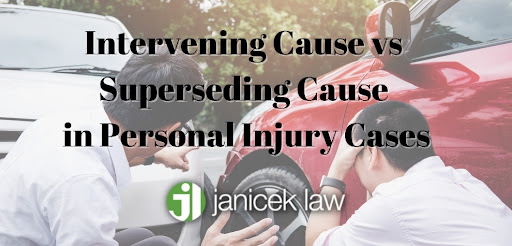Accidents are complicated events. And when an accident involves injured parties, multiple factors may complicate matters further. When injured victims need compensation for the costs associated with their injury caused by a third party, they must file a personal injury lawsuit. In order to move forward with their claim, they must prove that another party was at fault for their injury. This is where many victims get confused regarding intervening vs superseding cause in Texas. They also come to our attorneys for assistance in understanding proximate cause vs cause in fact.
To begin a Texas Prima Facie Case, the injured party must present enough basic evidence to show that the defendant’s negligence likely caused the harm.
In order to prove fault, the injured party must first establish the element of negligence. Part of establishing negligence requires showing that the at-fault party’s action or inaction was a cause of the injuries.
Tanto las causas intervinientes como las sustitutivas pueden desdibujar las líneas para aquellos que intentan establecer la culpa en sus casos de lesiones personales. En algunos casos, estas causas pueden disminuir o anular la responsabilidad del demandado.
Esto significa que para las víctimas de lesiones personales, las causas intermedias y sustitutivas pueden reducir o eliminar la capacidad de recibir daños adecuados por las lesiones sufridas.
Liability in a personal injury case hinges on proving that a defendant’s negligent action connects directly to the accident or event. When faced with this situation, you need the guidance and experience of a Abogado de lesiones personales en San Antonio en Janicek Law.
Causa Próxima, Causa Interviniente y Causa Supercedente en Accidentes de Terceros
Any time a third party is introduced in a scenario, things get more complicated. This is exacerbated when an accident occurs. Accidents such as car wrecks, slips or trips, and falls, incidents on construction sites, and more are examples of personal injuries typically caused by a third party.
La noción de causas próximas, intervinientes y sustitutivas crea un área gris, lo que dificulta que las víctimas reciban una compensación justa por las lesiones sufridas como resultado de la negligencia de la parte culpable.
¿Cuáles son estas causas y cómo afectan las reclamaciones por lesiones personales?

Proximate Cause Definition
En casos de lesiones personales, la causa próxima es simplemente la causa legal del accidente.
Cuando las acciones de la parte responsable ocurren en una cadena ininterrumpida de eventos y causan lesiones directamente, son la causa próxima del accidente.
The claimant must prove that the proximate cause of the accident and the injuries that occurred as a result of the accident wouldn’t have occurred if not for the defendant’s negligence.
Proving the following two elements establishes proximate cause in a personal injury claim:
Proximate Cause vs Cause in Fact
La causa de hecho es el vínculo entre las acciones de la parte culpable y los daños sufridos por la parte perjudicada. La lesión existe debido a las acciones realizadas (o no realizadas) por la parte negligente.
Proximate cause takes this a step further. It asks whether the harm was a foreseeable result. Even if the defendant caused an accident in fact, they are only liable if the harm was something that a reasonable person could have reasonably foreseen.
So, cause in fact covers what actually happened, while proximate cause covers whether Texas law says the defendant should be held accountable for it.
Actual vs Proximate Cause
The actual cause is also called the cause in fact. So, the same applies as above.
Los casos que involucran múltiples causas próximas se vuelven cada vez más complejos.
To better understand how responsibility occurs in personal injury cases, it’s crucial to revisit the basic definition of negligence. So, what is negligence in Texas?
In Texas, negligence occurs when a person or entity fails to exercise reasonable care and this causes harm to someone else.
Proximate Cause Example
Here is a proximate cause example:
A driver runs a red light, crashing into another vehicle and injuring the other driver. This was a foreseeable result, so the driver’s negligence was the proximate cause of the victim’s injury.
However, if the collision causes a nearby power line to fall and this leads to a fire that seriously burns someone else, that victim’s injury may not be considered a foreseeable result under Texas law.
Here, the driver who ran the light may not be the proximate cause of the burn injuries, even if they started the chain of events that led to the burn.
For legal assistance, contact a San Antonio car wreck attorney from our legal team.

¿Qué es una causa interviniente?
Todo acto que rompa el vínculo directo entre la actuación del imputado y las lesiones de la víctima, después de la actuación negligente, es causa interviniente.
Una causa interviniente puede ser la acción de un tercero o un acto de la naturaleza.
If a truck accident eyewitness tries to help a victim but instead worsens the injuries, this is an example of an intervening cause.
So, unlike a proximate cause, an intervening cause could potentially lessen or remove a defendant’s liability. However, in both cases, the original defendant is typically considered partially liable for the damages, even when an intervening cause is present. The defendant is relieved of their liability only if the event was not foreseeable to a reasonable person.
If you’ve been injured in a San Antonio truck accident, consult our legal team to learn more.
Tipos de causas intervinientes
Existen dos tipos de causas intervinientes. Estos son dependientes e independientes.
Causa interviniente dependiente
La causa interviniente dependiente se deriva de la conducta del imputado. A menos que sea extraordinario, la responsabilidad del demandado permanece.
Causa interviniente independiente
Un acusado no tiene culpa por una causa interviniente independiente. A menos que el evento fuera previsible, libera al demandado de responsabilidad.
However, some premises liability cases involve small children who are injured by hazardous conditions. The Texas attractive nuisance doctrine may apply when property owners fail to secure features that might entice a child. If the property owner doesn’t have children, they may not realize that small kids are extremely curious, especially if there’s a pool or a dangerous dog wandering in a yard. This lack of understanding surrounding children does not relieve the property owner of their responsibility under Texas law.
If your child was injured on someone else’s property in San Antonio, a skilled attorney at our firm can help.
Superseding Cause Definition
Una causa primordial evita que un reclamante establezca una causa próxima en un accidente. Anula o reemplaza la responsabilidad por accidentes del acusado. Sirve como una poderosa defensa contra reclamos de negligencia. Eso es porque la causa superior prueba que algo o alguien más, no las acciones del acusado, sirvieron como la causa próxima del accidente.
Often, a defendant may avoid liability when a superseding cause exists. It weakens the connection between the claimant’s injuries and the defendant’s actions.
A superseding cause is also one that cannot be foreseen.
Why Would a Superseding Cause Relieve a Tort Defendant of Liability?
A superseding cause can relieve a tort defendant because it breaks down the chain of causation between the defendant’s actions or negligence and the victim’s injury.
In Texas, defendants are only liable if their actions or negligence were the proximate cause of injuries. However, if an unforeseeable and independent event occurs after this act or negligence, and the new event is actually what causes harm, then the original defendant can no longer be held accountable.
Superseding Cause Examples
- A construction company leaves a major hole uncovered without proper signage. This is negligent.
- Hours later, a drunk driver crashes, runs off the road, and hits a pedestrian, knocking them into the hole. This is also negligent.
Here, the construction company created a dangerous condition, but the unforeseeable drunk driver could be considered a superseding cause. The drunk driver was independent. The crash was not caused by the construction work. The drunk driver’s collision was so unexpected that it will break the chain of causation for the construction company.
If you’ve been injured by a drunk driver in San Antonio or if you were injured on a San Antonio construction site, our law firm can help.
Another example of a superseding cause is when a product manufacturer includes appropriate warnings on its packaging, which a retailer later removes. The retailer’s actions are a superseding cause if a consumer receives an injury. The product manufacturer may be protected from liability.
If you’ve been harmed by a defective product in San Antonio, our lawyers can also assist with this.

What is an Independent Cause?
Under Texas law, an independent cause refers to something unexpected that happens after the defendant’s negligence or action that causes harm. If the new event is crucial enough on its own to cause harm, and if the new event could not have been reasonably foreseeable, the originally negligent person may not be held accountable.
This is because their actions or negligence are no longer viewed as the main cause of the accident or personal injury.
Superseding vs Intervening Cause
Foreseeability is the primary difference between an intervening cause and a superseding cause. This is a personal injury concept that attorneys use to determine what caused an accident. Foreseeability measures whether or not a reasonable person should have foreseen the consequences of the negligent person’s actions.
Un acto interviniente se convierte en una causa superior que elimina la responsabilidad del demandado si y solo si la acción debería haber sido previsible para el demandado.
In some premises liability cases, defendants may try to minimize responsibility by asserting the open and obvious defense in Texas, claiming the hazardous condition was so obvious that the victim should have avoided it.
Foreseeability is the Test for Proximate Cause
El alcance de la responsabilidad generalmente se basa en la previsibilidad del método y el tipo de daño. La cuantía del daño causado no lo restringe.
Unforeseeable Type of Harm: If the harm doesn’t foreseeably stem from negligent behavior, then the third party is not liable for the plaintiff’s injury.
Unforeseeable Manner of Harm: If the superseding cause was unforeseeable, then the injured party cannot hold the person who caused the injury responsible for the injury. This is because the superseding act breaks the direct link between the damage and the action that caused it. When this happens, the at-fault person is often relieved of responsibility.
Examples of unforeseeable superseding causes include, but are not limited to:
- Huracanes, terremotos y otros actos de Dios
- Third-party torts and criminal acts, such as burglary, attacks, or injuries that occur on another’s property
We commonly handle personal injury lawsuits for crimes in San Antonio, and are adept at proving the defendant’s negligence in such cases.
Los ejemplos de causas sustitutivas previsibles incluyen (el demandado no escapa a la responsabilidad):
- Daño infligido por rescatistas como bomberos, personal médico y otras personas que brindan ayuda
- Negligencia ordinaria de los trabajadores de la salud
- Lesión o enfermedad adicional que ocurre debido a la condición disminuida de la parte lesionada
Para malpractice claims assistance in San Antonio, consult our skilled attorneys.
Alcance imprevisible del daño
Ya sea que el daño sea predecible o no, una persona que causa daño a otra es responsable en toda su extensión.
La regla del “cráneo de cáscara de huevo”
La premisa de la Regla de la “Calavera de cáscara de huevo” es que una persona razonable tomaría las lesiones que sufrió la víctima al pie de la letra, sin profundizar en los detalles de lo que podría haber sucedido o no si la víctima lesionada no tuviera una condición preexistente.
Tomemos, por ejemplo, un accidente que causaría unos pocos miles de dólares en daños en circunstancias normales, pero la persona lesionada tiene una condición rara que agrava las lesiones. Debido al factor adicional de la condición de salud existente de la víctima, ahora necesitan $125,000 en atención médica para sus lesiones por accidentes. El actor negligente es responsable por el monto total de las lesiones de la víctima.
The Eggshell Rule protects victims who aren’t at fault for their condition. Defendants must take full responsibility for the injuries they’ve caused, regardless of whether the cost would differ if the victim didn’t have preexisting conditions that exacerbated the injury.
Superseding Intervening Cause in Injury Cases
En el caso promedio de lesiones personales, el "pero para la prueba" puede utilizarse para determinar la causalidad de los daños sufridos por la víctima. La prueba cuestiona si la víctima habría sufrido o no las lesiones si no hubiera sido por las acciones negligentes o la inacción.
Si la respuesta es “no”, entonces el acusado es responsable de las lesiones de la víctima.
Cualesquiera causas intervinientes o sustitutivas se consideran al determinar la responsabilidad. Si bien la presencia de una causa intermedia probablemente no eliminará la responsabilidad del demandado por las lesiones del demandante, puede compartir la responsabilidad con la parte responsable de la causa intermedia.
Un caso con una causa sustitutiva puede brindarle al acusado una protección total contra la responsabilidad. Un reclamante puede verse obligado a presentar una demanda contra la parte que causó el acto sustitutivo si esto sucede.
Además, es posible que las víctimas de lesiones no puedan presentar un caso de lesiones personales si la causa principal fue un acto de Dios.
Additionally, there are also situations where the victim knowingly exposes themselves to danger for whatever reason. Under the Texas assumption of risk doctrine, defendants can argue that plaintiffs voluntarily accepted the known hazards. This can reduce or totally eliminate liability in specific personal injury claims.
¿Puede presentar un reclamo por lesiones personales?
Las víctimas de lesiones deben probar negligencia para tener un caso viable de lesiones personales. Esto implica establecer una causa próxima. Solo una vez que el abogado de lesiones personales establezca la causa próxima, el lesionado puede presentar un reclamo por lesiones personales. Las víctimas lesionadas pueden presentar una demanda por lesiones personales contra varias partes.
Como se mencionó, si existe un evento de reemplazo y tiene mérito suficiente, las víctimas pueden presentar un reclamo contra la parte responsable del evento.
Los reclamos por lesiones personales pueden complicarse rápidamente, por lo que alentamos a aquellos que deseen presentar un reclamo a obtener asesoría legal competente lo más rápido posible. Los abogados expertos de Janicek Law están bien versados en la intervención o sustitución de causas. Explorarán las opciones legales en una consulta gratuita y diseñarán la mejor estrategia para un resultado exitoso.

Los abogados con experiencia en lesiones personales de San Antonio pueden ayudar
El Abogados de lesiones personales en San Antonio en Janicek Law tienen una amplia experiencia con agravios de causa superior. Garantizar que nuestros clientes reciban una compensación completa y justa por las lesiones que sufren debido a la negligencia de otra persona o de un tercero es siempre nuestro objetivo.
Investigamos a fondo la causa legal de su problema crítico y tenemos el conocimiento y la habilidad necesarios para presentar un caso sólido ante un jurado y ganar. Llame hoy a los súper abogados de Janicek Law para una consulta gratuita sobre su caso de causa interviniente reemplazante. nuestro número de teléfono es (210) 366-4949.
Our firm also handles various legal issues, including San Antonio 18-wheeler accidents, Abuso en un asilo de ancianos de San Antonio, y más.
Establezca su relación abogado-cliente con nuestro bufete de abogados llamando para programar una consulta gratuita hoy.

